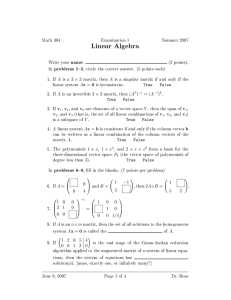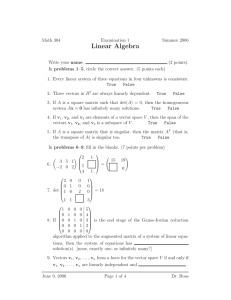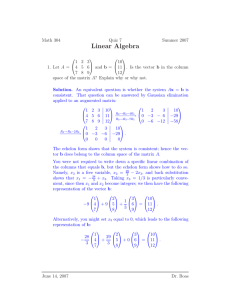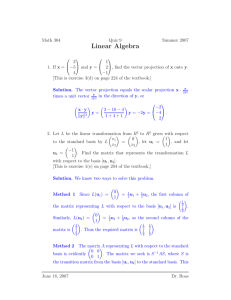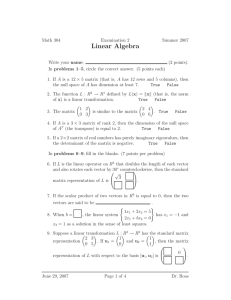Linear Algebra
advertisement
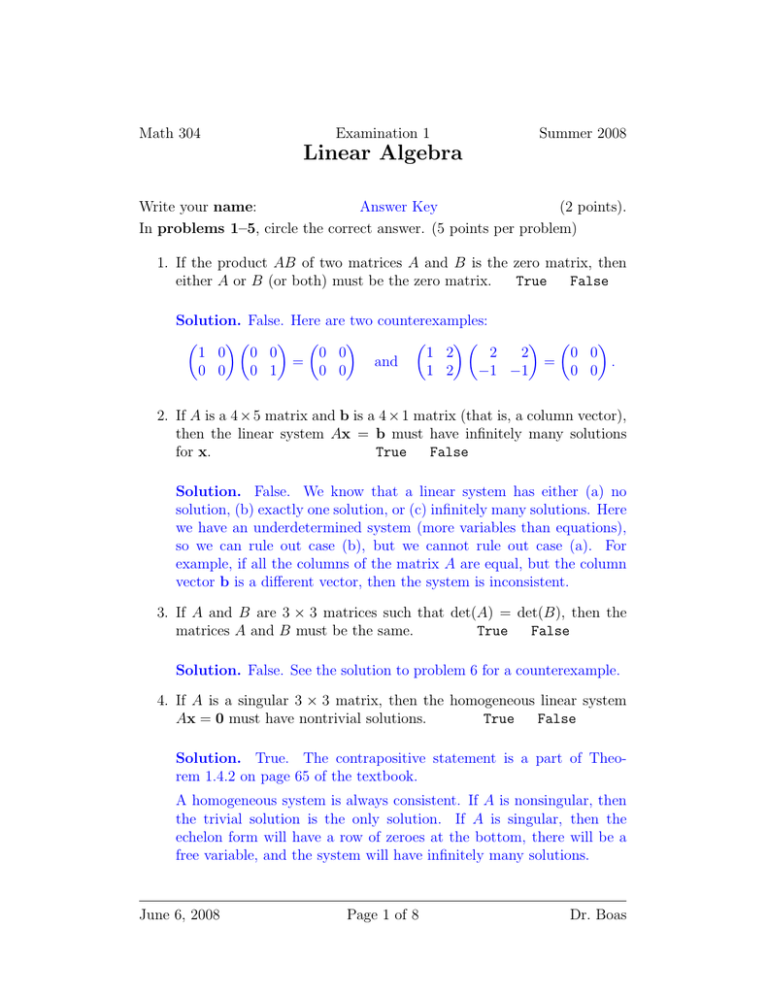
Math 304 Examination 1 Summer 2008 Linear Algebra Write your name: Answer Key (2 points). In problems 1–5, circle the correct answer. (5 points per problem) 1. If the product AB of two matrices A and B is the zero matrix, then either A or B (or both) must be the zero matrix. True False Solution. False. Here are two counterexamples: 1 0 0 0 0 0 1 2 2 2 0 0 = and = . 0 0 0 1 0 0 1 2 −1 −1 0 0 2. If A is a 4 × 5 matrix and b is a 4 × 1 matrix (that is, a column vector), then the linear system Ax = b must have infinitely many solutions for x. True False Solution. False. We know that a linear system has either (a) no solution, (b) exactly one solution, or (c) infinitely many solutions. Here we have an underdetermined system (more variables than equations), so we can rule out case (b), but we cannot rule out case (a). For example, if all the columns of the matrix A are equal, but the column vector b is a different vector, then the system is inconsistent. 3. If A and B are 3 × 3 matrices such that det(A) = det(B), then the matrices A and B must be the same. True False Solution. False. See the solution to problem 6 for a counterexample. 4. If A is a singular 3 × 3 matrix, then the homogeneous linear system Ax = 0 must have nontrivial solutions. True False Solution. True. The contrapositive statement is a part of Theorem 1.4.2 on page 65 of the textbook. A homogeneous system is always consistent. If A is nonsingular, then the trivial solution is the only solution. If A is singular, then the echelon form will have a row of zeroes at the bottom, there will be a free variable, and the system will have infinitely many solutions. June 6, 2008 Page 1 of 8 Dr. Boas Math 304 Examination 1 Summer 2008 Linear Algebra 5. If n vectors v1 , v2 , . . . , vn are a spanning set for the vector space Rn , then they must also be a linearly independent set. True False Solution. True. If the vectors were linearly dependent, then one would be a linear combination of the others, so we could discard that vector and still have a spanning set. That is impossible, because the vector space Rn has dimension n: the space cannot have a spanning set consisting of n − 1 vectors. In problems 6–9, fill in the blanks. (7 points per problem) 1 2 = 10. (There are many correct answers.) 6. det 0 3 0 0 Solution. The determinant of a triangular matrix is the product of the elements on the diagonal, so you need to put numbers on the diagonal whose product equals 10. For example, 1 1 2 1 1 2 10 1 2 0 2 3 0 1 3 0 10 3 . or or 0 0 5 0 0 10 0 0 1/10 1 2 3 10 2 3 7. If A = and AB = , then B = 4 5 6 40 5 6 . Solution. First observe that B must be a 3 × 3 matrix. Next observe that the third column of AB equals the third column of A, the second column of AB equals the second column of A, and the first column of AB equals 10 times the first column of A. This effect is achieved by multiplying A on the right by a certain elementary matrix: namely, 10 0 0 B = 0 1 0 . 0 0 1 June 6, 2008 Page 2 of 8 Dr. Boas Math 304 Examination 1 Summer 2008 Linear Algebra 8. Let V be a vector space. The number of vectors in a basis for V is called the dimension of the vector space V . 1 5 1 0 1 5 9. Suppose A = = . (This is an LU factorization 2 11 2 1 0 1 for A.) The transpose matrix AT can be written as the product of a lower triangular matrix an upper triangular matrix as follows: times AT = 1 0 1 1 0 1 . Solution. The transpose of a product is the product of the transposes in reverse order, so you can immediately write down that 1 0 1 2 T A = . 5 1 0 1 1 2 Alternatively, you can work out the LU factorization of from 5 11 scratch. June 6, 2008 Page 3 of 8 Dr. Boas Math 304 Examination 1 Summer 2008 Linear Algebra In problems 10–12, show your work and explain your method. Continue on the back if you need more space. (15 points per problem) 10. Consider the system of simultaneous equations x1 + x2 + 2x3 = 1 2x1 + x2 + 3x3 = 2 4x1 + 2x2 + 6x3 = k for the unknowns x1 , x2 , and x3 . For which value(s) of k does this system have infinitely many solutions? Solution. Use Gaussian elimination to bring the augmented coefficient matrix to row echelon form: 1 1 2 1 1 1 2 1 R2→R2−2R1 2 1 3 2 − −−−−−−→ 0 −1 −1 0 R3→R3−4R1 4 2 6 k 0 −2 −2 k − 4 1 1 2 1 R2→−R2 −−−−−−−→ 0 1 1 0 . R3→R3+2R2 0 0 0k−4 If k 6= 4, then the system is inconsistent and has no solution. If k = 4, then the system is consistent and has x3 as a free variable, so there are infinitely many solutions. June 6, 2008 Page 4 of 8 Dr. Boas Math 304 Examination 1 Summer 2008 Linear Algebra 1 0 2 11. Find a basis for the null space of the matrix 1 1 −1 1 0 3 4 . 0 −2 Solution. Use Gaussian elimination to bring the augmented coefficient matrix to row echelon form: 1 0 1 0 0 1 0 1 0 0 R2→R2−R1 1 2 3 4 0 −−−−−−−→ 0 2 2 4 0 R3→R3−R1 1 −1 0 −2 0 0 −1 −1 −2 0 1 0 1 0 0 R2→ 21 R2 −−−−−−−→ 0 1 1 2 0 . R3→R3+R2 0 0 0 00 Now you can read off that x3 and x4 are free variables, x1 = −x3 , and x2 = −x3 − 2x4 . Therefore the general element in the null space can be expressed in the form −x3 −1 0 −x3 − 2x4 −1 −2 or x3 1 + x4 0 , x3 x4 0 1 where x3 and x4 are arbitrary. The two vectors −1 0 −1 −2 and 1 0 0 1 form a basis for the null space of the matrix. June 6, 2008 Page 5 of 8 Dr. Boas Math 304 Examination 1 Summer 2008 Linear Algebra 1 12. Suppose A = 2 1 3 1 4 2 and A−1 = 0 . 1 Fill in the missing entries, and explain your strategy for finding them. Solution. The thematic approach is to compute the inverse matrix by using row operations, although the missing entries cause some complications. It is, however, possible to solve the problem using nothing more than the knowledge of how matrix multiplication works. Method 1 To avoid introducing nine variables for the nine unknown entries, let an asterisk mean, “I don’t know the value of this entry.” Thus asterisks in two different places may represent two different (unknown) numbers. As usual, start the algorithm for finding an inverse matrix by working on the first column of an augmented matrix: 1 1 1 1 0 0 1 1 1 1 0 0 R2→R2−2R1 2 3 2 0 1 0 − −−−−−−→ 0 1 0 −2 1 0 . R3→R3−∗R1 ∗ ∗ ∗0 0 1 0 ∗ ∗ ∗ 0 1 Next work on the second column: 1 0 1 3 −1 0 R1→R1−R2 1 0 . −−−−−−−→ 0 1 0 −2 R3→R3−∗R2 0 0 ∗ ∗ ∗ 1 Since we know that the matrix A is invertible, the unknown entry in position 33 cannot be 0, so we can divide it out: 1 0 1 3 −1 0 R3→(1/∗)R3 1 0 . −−−−−−−→ 0 1 0 −2 0 0 1 ∗ ∗ ∗ Now we can perform the final step inverse matrix: 1 0 R1→R1−R3 −−−−−−−→ 0 1 0 0 June 6, 2008 in the algorithm for finding the 0 ∗ ∗ ∗ 0 −2 1 0 . 1 ∗ ∗ ∗ Page 6 of 8 Dr. Boas Math 304 Examination 1 Summer 2008 Linear Algebra We have not yet completely solved the problem, but we now know the middle row of A−1 . Putting this information together with what was given, we have 4 0 ∗ A−1 = −2 1 0 . ∗ ∗ 1 Since A times A−1 matrix equation: 1 2 ∗ equals the identity matrix, we have the following 1 1 4 0 ∗ 1 0 0 3 2 −2 1 0 = 0 1 0 . ∗ ∗ ∗ ∗ 1 0 0 1 You can read off the three missing entries in A−1 by looking at the products that correspond to the entries on the top row of the identity matrix. For instance, 4 1 1 1 −2 = 1, ∗ so the missing entry in position 31 of the matrix A−1 equals −1. Arguing similarly for the other two missing entries shows that 4 0 −1 1 0 . A−1 = −2 −1 −1 1 Now A−1 A equals the identity matrix, so 4 0 −1 1 1 1 1 0 0 −2 1 0 2 3 2 = 0 1 0 . −1 −1 1 ∗ ∗ ∗ 0 0 1 You can read off the missing entries in A by again looking at the products that correspond to the entries on the top row of the identity matrix: 1 1 1 A = 2 3 2 . 3 4 4 June 6, 2008 Page 7 of 8 Dr. Boas Math 304 Examination 1 Summer 2008 Linear Algebra Method 2 (sketch) Give the 1 2 x missing entries of A symbolic names: 1 1 3 2 . y z Now run the algorithm for finding A−1 , keeping track of all the entries. If you are good with algebra, or if you have a calculator that is sufficiently sophisticated to produce the inverse of a symbolic matrix, you will find that 1 2y − 3z z − y x−z x − z x − z −1 −2 1 0 . A = 3x − 2y y − x −1 x−z x−z x−z [Remark: det(A) = z − x.] Comparing this symbolic inverse with the three given entries of A−1 produces three equations for the three unknowns x, y, and z. Solve these equations and substitute the values for x, y, and z back into the symbolic form of A−1 . Now A−1 is completely known. Proceed as in Method 1 to find the missing entries of A by using that A−1 A = I. Method 3 (sketch) Give the six missing entries of A−1 symbolic names. Using the known first two rows of A and the knowledge that AA−1 = I produces six equations for these six unknowns. These equations are actually easy to solve, because they split up into three pairs of equations, each pair involving only two of the unknowns. After solving the three sets of two equations in two unknowns, you have all the entries of A−1 . As was the case in Methods 1 and 2, it is easy to get the three missing entries of A by using that A−1 A = I. June 6, 2008 Page 8 of 8 Dr. Boas

